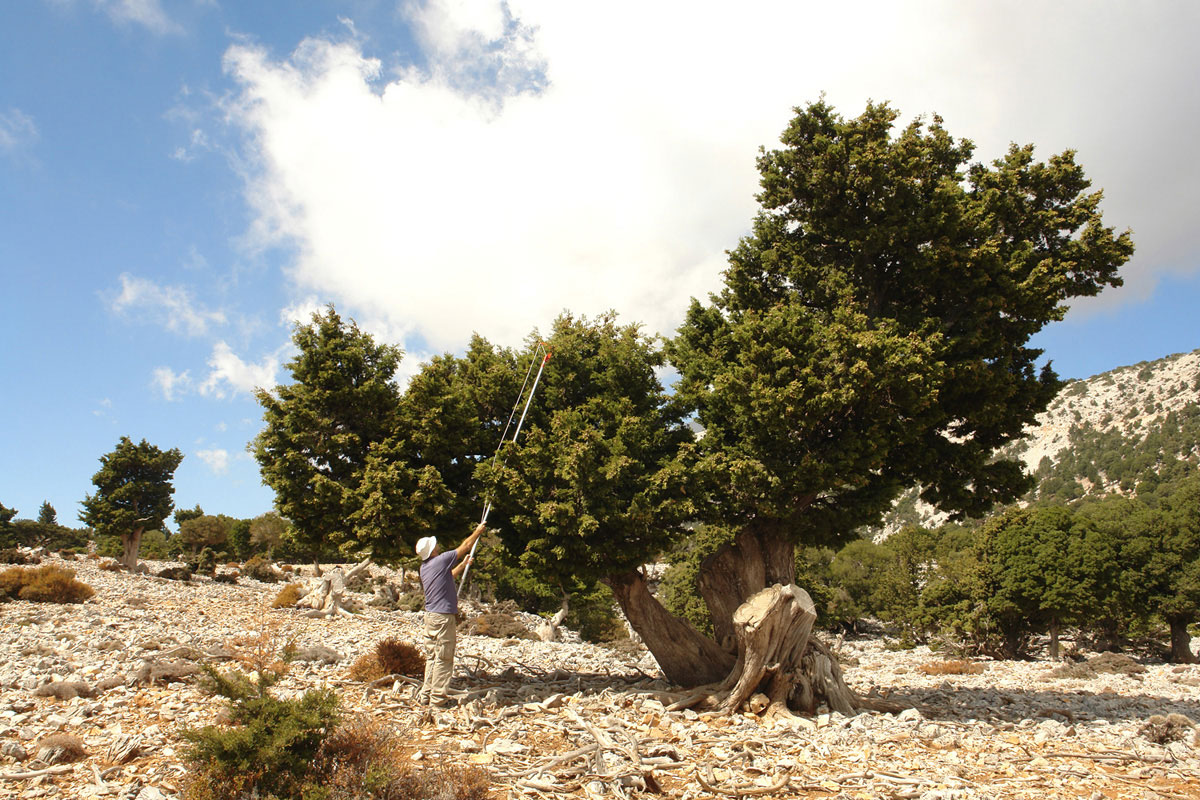Main menu
Conservation of priority forests and forest openings in "Ethnikos Drymos Oitis" and "Oros Kallidromo" of Sterea Ellada, LIFE11 NAT/GR/1014
Actions
Action C.5: Restoration of Juniperus foetidissima forests (9560*)

This is a pilot restoration action, aiming to improve the conservation status and increase the area of the habitat of Juniperus foetidissima forests (9560*) on Mt. Oiti. It will be implemented according to the specifications of action A.7 and will start on the second year of the project.
Reinforcement of the population of Juniperus foetidissima will take place at the currently existing 9 ha of habitat 9560*. In this area, the improvement of the conservation status will include interventions aimed to improve the regeneration potential of Juniperus foetidissima (e.g., protection of seedling and sapling, and restoration of a favourable sex ratio).
The increase of the area of the habitat will include re-introduction of the habitat 9560* at 2 new locations, where it will be restored from scratch by planting of Juniperus foetidissima and keystone species. The reintroduction of the habitat 9560* is envisaged to take place at two sites (map 1): Greveno peak at an area of 200,000 – 250,000 m2 (20 – 25 ha) and Alykaina peak at an area of some 200,000 m2 (20 ha). These two sites are currently covered by heath and provide suitable conditions for the restoration of habitat 9560*, but the final selection of the restoration sites will be determined by action A.7.
Juniperus foetidissima new plants will be produced at the nurseries of NAGREF, starting at the first year of the project. Production of new plants will be made by inoculation of Juniperus foetidissima grafts from local trees to high-altitude cypress (Cupressus sempervirens) plants from Kriti (where there are native wild high-altitude cypress trees) and will continue throughout the project duration. The gender of the grafts will be selected so as to ensure the necessary male-female balance, as specified by action A.7. In the first year of the project, cypress seeds will be collected and cypress plantlets grown. In the second year inoculations will be made and inoculated plants will be grown in the nursery. In the third year young Juniperus foetidissima plants will be ready for planting. Before planting, the saplings will be transferred to the Botanical Garden of the Natural History Museum of Oiti for a 6-month acclimatization to local conditions. Then, approximately 2,000 Juniperus foetidissima saplings will be planted at Greveno and some 1,000 saplings will be planted at Alykaina. The restoration will also include planting of certain keystone species (e.g., Daphne oleoides, Crataegus orientalis), the selection and quantity of which will be specified by action A.7.
Planting will be done manually at planting pits of 0.40x0.40x0.40 m3 to 0.50x0.50x0.50 m3, made either by mechanical means or manually, depending on the inclination (dimensions may be altered as specified by action A.7). The layout for planting will be according to the specifications of action A.7. Irrigation will not be necessary because the dry season in these areas is short (less than two months), and a mixture of soil and expanded perlite will ensure adequate moisture for the young plants. The planting pits will be covered with a special plastic sheet in order to prevent the development of competing vegetation and to provide better soil moisture conditions. Reformation of the planting pits to improve water retention, if necessary, and replacement of plants that may have failed will take place in the autumn of the second year after planting. Thereafter, replenishment of the plantations will be made annually, as necessary.
Detailed recording of the whole process will be made and the results will be monitored by action D.3.
Action C.5 includes:
- Reinforcement of the population of Juniperus foetidissima at the currently existing 9 ha of habitat 9560*.
- Re-introduction of Juniperus foetidissima at 40 – 45 ha of newly created habitat 9560* at 2 locations where there is currently no habitat.
It is noted that action C.5 does not intend to re-introduce a threatened species, but a threatened habitat, Juniperus foetidissima forests. It is true that this includes reinforcement and re-introduction of the population of Juniperus foetidissima which is the characteristic species of the habitat, but the whole concept is different and the guidelines do not strictly apply in this case. Nevertheless, in brief, the conditions for re-introduction (as stated in Guidelines for Applicants) are met because:
- The areas selected are within the historical distribution range of both the species Juniperus foetidissima and the habitat, and they have the appropriate abiotic conditions regarding altitude, substrate, and climate.
- The justification of the re-introduction and the subject of threats are addressed in detail. We should note that the known threats, fire and inadequate regeneration, are addressed by the project. We believe that the above guarantee reasonably high chances of success (the main difficulties concern the propagation of the species).
- The action does not involve removal or translocation of wild source individuals, since we will reproduce and propagate the species ex situ and for this we will use genetic material from the local population.
- Action A.7 is a preparatory phase and the deliverables include a feasibility study; action D.3 includes a follow-up phase.
On Mt. Oiti, Juniperus foetidissima has suffered destructive human pressure because in the past its valuable rot-proof wood was used extensively in buildings and in the manufacture of agricultural tools. It is also believed that grazing and fires, especially in the past, restricted the distribution area of this habitat. In general, it is considered that habitat 9560* could have been more extended in the past on the skeletal limestone steep slopes of Mt. Oiti. This situation of 9560* with Juniperus foetidissima is similar in most, if not all, of its stations in Greece. Currently logging is illegal and of small magnitude (yet the impact is not negligible), and wild fires are not too frequent.
However, habitat 9560* is restricted to only 9 ha in Oiti and it is apparent that it cannot recover its area naturally. This may be due to the diminished regeneration potential of Juniperus foetidissima and to age-long grazing. Indeed, it is assumed that the most important threat for 9560* with Juniperus foetidissima in Greece, as well as in GR2440004, is that the natural regeneration of the species is reportedly poor to nil throughout the country. Observations of the reproductive biology of Juniperus foetidissima for several years at various stations in Greece have indicated that it maintains a very low percentage of sound seeds (< 5 %). The potential impacts of wild fires and Global Climatic Change are aggravated by the lack of regeneration. Thus, 9560* is a priority habitat type, which, although not imminently threatened in GR2440004, is vulnerable to a single destructive event such as an extensive fire, because of its small area and lack of regeneration.
Restoration, including population reinforcement and re-introduction to more locations, will improve the future prospects of this habitat. Moreover, the knowledge acquired from the pilot restoration on Mt. Oiti will be a valuable tool for similar efforts at other sites of Greece and of other European countries
- The area of Juniperus foetidissima forests on Mt. Oiti will be increased by approximately 40 ha.
- A manual with guidelines for the restoration of Juniperus foetidissima forests.



 news
news









